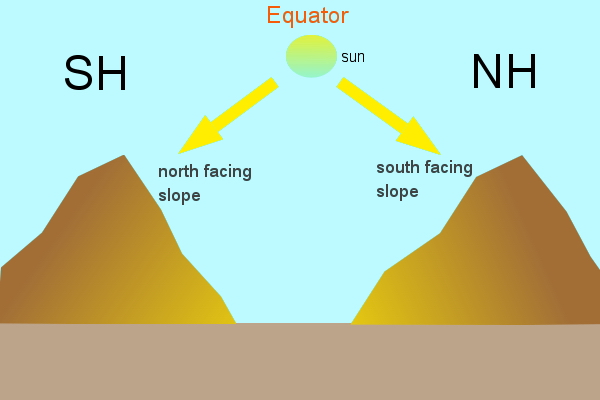Long term factors
Sun’s Altitude
The sun heats directly at the equator than at the poles, this is because the sun rays has more atmosphere to pass through to get to the poles. By the time it reaches the surface more energy (heat) would have been lost by scattering and reflected by clouds. In addition, the little isolation received is reflected by snow covered surfaces.

Ocean Currents
These are huge movements of water in the oceans. Currents move away from the equator to the poles where, upon being heated, are light (less dense) thus move on top of the ocean. These currents raise coastal temperatures of polar regions. Currents originating from poles are cold and dense due to added weight of ice thus sink downwards and migrate towards the equator were they can lower coastal temperatures in their wake e.g. The Cold Benguela Current originating from Antarctica sweeps the Namibian coast and summons fish to the surface.. Due to the Coriolis Effect, currents are deflected to the right in the NH and to the left in the SH.
Altitude of Land
Temperature decreases with altitude, thus higher land is relatively cold as it is further from the main heat source, the ground. That is why snow is present on top of mountains.
Specific Heat
Refers to the amount of energy needed to heat a unit mass of air. Land and sea have different specific heat capacity. Land heats up more quickly and have low retention, conversely the sea heats up slowly but have a higher retention rate. Thus in summer the land is warmer while the sea is cold and in winter land is colder and sea is warmer. This determines wind temperature.
Prevailing winds
In summer, winds blowing from the sea tend to be colder than inland winds. Conversely, in winter, winds from sea are warmer than those blowing from inland.
Short term factors
Seasonal Changes:
The sun is head-on at the equator during the autumn and spring equinoxes (21 March -22 September) thus temperatures are distributed equally. Earth’s tilt result in the sun being overhead at the tropics (Tropic of Cancer (NH) and Capricorn (SH) at the summer and winter solstices (21 June-22 December). The hemisphere with summer have the highest insolation. In Zimbabwe, highest insolation is received between December and March as the sun is overhead at the Tropic of Capricorn.
Length of day and night:
In winter, day time is short and night period is long whereas in summer day time is long (more temperature) and night time short. At the equator, length of day and night is equal all year round.
Local Factors
Aspect
In the Southern Hemisphere south facing slopes receive little insolation because the slopes are behind sun’s rays whereas north facing slopes receive maximum insolation. Conversely, in the Northern Hemisphere, south facing slopes receive maximum insolation.

Urbanisation
Gases from vehicles, industries and lack of vegetation means a more enhanced greenhouse is concentrated along urban areas which raises urban temperatures.
Amount of cloud cover
Dense cloud cover means more heat will be reflected and scattered thus lowers temperatures whereas clear skies promote more insolation during the day and lose heat more at night (desert).

